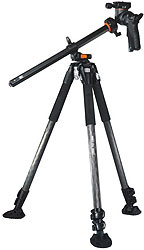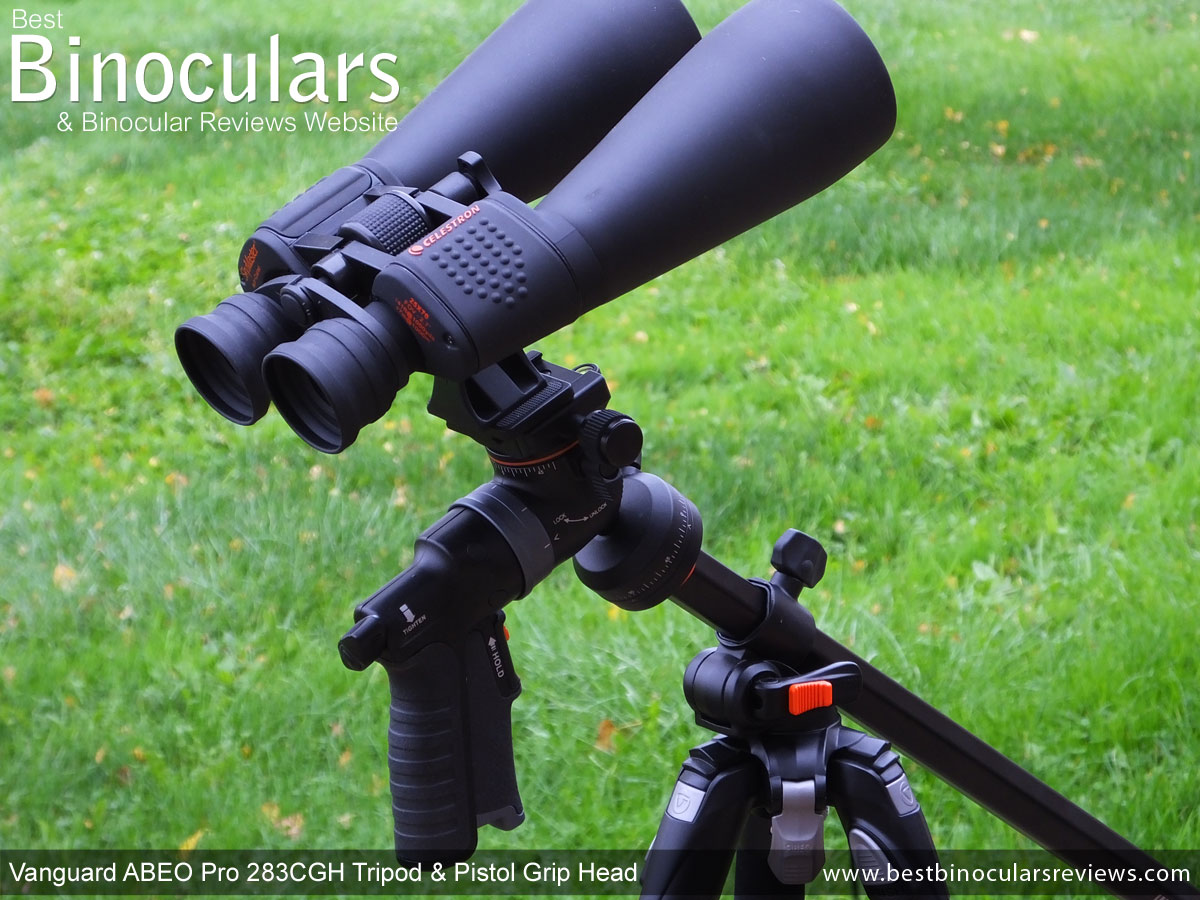
In this guide, I will take you through my personal favorite tripod setups (tripods, tripod heads & tripod adapters) that I use for my astronomy binoculars as well as for long-range daytime bino surveillance on land, out to sea and up towards the sky for uses like observing eagles and plane spotting.
As you may have noticed by the increase in the number of related reviews and articles on BBR about binoculars that are specifically designed for astronomy as well as long-range terrestrial surveillance, my interest in these areas has deepened and as such, I am using my binoculars with a tripod far more often. This has also resulted in me receiving more and more questions in regards to not only what binoculars are best for these uses, but what tripod is best for use with binoculars.

So rather than having to answer all these questions individually (often repeating myself), I have decided to put together my personal guide to the best tripod setup for binoculars that I have used:
Please Note: Whilst I have tested many hundreds of pairs of binoculars, I certainly don’t have anywhere near as much experience when it comes to testing such a wide variety of tripods and thus don’t consider myself to be a big expert in this field. This guide is on from my point of view and personal experience.

But what I will add is that along with the fact that I often using tripods with binoculars and spotting scopes, I am also a keen (but very amateur) birding and wildlife photographer and because of this I have bought, owned, used and indeed reviewed a fair amount of tripods and tripod heads over the years and thus whilst I have not tested hundreds of setups, I do feel that I certainly know what I like and don’t like and what to look for in a good tripod setup. Thus based on this, I hope that at least some of my advice below is both informative and helpful to you:
My Current Tripod Setup I Use for Binoculars
Over the years, I have slowly refined my tripod set up to the point where I am very happy with the gear that I now have and use and so think the best way for me to go about this article is to run through my current equipment and explain what I like about it, what I don’t and how I interchange and use different tripod heads depending exactly which binoculars I am using and what the intended use is:
Tripod Adapters
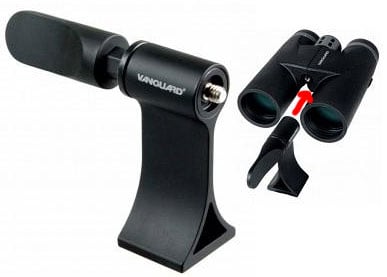
To begin with, you will need an adapter that you attach to your binocular which then fits onto the tripod head.
Most binoculars are what we call “tripod adaptable” meaning that they will accept a “standard” tripod adapter which you screw into the thread at the front of the central hinge on your binocular.
These are relatively inexpensive, easy to obtain and it is very easy to do.
Some binoculars won’t have this or will use a different system, but there is pretty always some way in which you can do it.
Apart from making sure you get the right type of adapter for your particular binoculars (99% of the time it is a standard adapter), I don’t really have a preference as they all pretty much work the same, but my main piece of advice would be to not get a very cheap plastic one. There is no point in getting a very sturdy tripod, only to have a tripod adapter that is unstable and easily breaks!
For more details, the different types and where to buy read my guide to the Binocular Tripod Adapter.
Tripods
I currently have three full-sized ones that I use on a regular basis:
My favorite one and indeed the one I use most often for most of my binocular and photography uses is the Vanguard Abeo Pro 283CT Tripod which I have now had for I would say about five years.
It has carbon fiber legs (CT = Carbon Tripod) and I actually got it as an upgrade from the less expensive, but heavier, aluminum Vanguard Alta Pro 263AT Tripod (AT = Aluminium Tripod) which in terms of its function is quite similar, is sturdy and works very well, but is a fair bit heavier.
Stability & Weight
As the main reason for fixing your binoculars onto a tripod is to increase stability, I think this is the best place to start when looking for a tripod.
However, as with binoculars, there are always trade-offs to be had. So a very steady and robust tripod is often also a heavy tripod. This is not really a problem if all you want to do is set it up on your balcony, but it is not so great if you want to carry it about with you when out in the field.
I often take my tripod with me out in the field and thus, even though I think that the Alta 263AT is good (Indeed I still have and use it in my studio and around the house), the one I usually reach for when going out is the Abeo Pro 283CT.
Aluminum vs Carbon
So for me personally ND how I often use my tripod, I think that the increase in price for a good lightweight carbon tripod was worth it, but for those who are less mobile, then I would suggest than an aluminum tripod like the Alta Pro 263AT is more than fine.
Also, keep in mind that some metal tripods can be more secure and stable than the carbon equivalent and thus may be more suitable if you plan on mounting a giant pair of astronomy binoculars onto them.
Tripod Height
When using your tripod with binoculars, unless you are sitting down (which I sometimes do, especially for astronomy), the tripod legs are likely going to be fully extended and perhaps even the central column as well.
In this state, stability is particularly important: Is it all very well having a tripod that is extremely steady when it is in its compact state, but where it is really needed is when it is fully loaded and fully extended. Once again, in this regard, I have been extremely happy with both of my Vanguard tripods.
Also keep in mind the height of the tripod that you intend on purchasing, not forgetting to add the height of the tripod head into the equation.
Standing
Height: Terrestrial Uses
For maximum comfort and ease of use, you need the setup to be high enough so that you are able to look through the binoculars whilst standing up.
Height: Sky & Astronomy
When looking up at the sky, in terms of height, things get even more complicated as unless you have binoculars with angled eyepieces (which some Astro binoculars do actually have) you need to get yourself under the binoculars.
The Abeo Pro 283CT Tripod has an advertised maximum height (extended) of 1m 55cm (61.02in) which is a little on the safe side as I have just measured mine to be a little more at 159cm (with the legs splayed).
Considering that I am 5ft 8in (1.74m) tall, this may not seem to be enough, but when you factor in the extra height of the pistol grip tripod head (see below) and the tripod adapter, it is just enough for me to get under the setup and look, although I do have to bend my knees slightly, which increases the more vertically you point the binoculars.
Here my Vanguard Alta Pro 263AT Tripod has the advantage as it has an advertised maximum height of 1m 65cm (65 inches) which is about right.
So once I have added the tripod head and tripod adapter, I personally can get myself in a very comfortable position under it and only have to slightly bend my knees when pointing the binoculars vertically.
So because of this and it’s extra weight, I generally keep this tripod at home for astronomy.
Sitting
Terrestrial Uses:
Depending on your situation and preferences, sitting in front of your binocular and tripod setup is certainly an option and is a popular choice for many long ranges uses like watching ships out at sea or viewing wildlife from a static location.

Some hunters will also take a tripod with them and sit on the ground when glassing over long distances. The advantage of this is you do not need such a large tripod and in this situation, you can even get away with using a lightweight travel tripod which usually folds up into a very small shape making them super easy to carry about.
Sky & Astronomy
Sitting Under the Tripod is certainly an option for when you need to point your binoculars skyward, be that at night for stargazing or during the day for uses like plane spotting or even following high flying birds like eagles.
Sometimes the problem with this technique can be that it can be quite difficult to position yourself comfortably with a chair under the tripod as the legs of the tripod and your chair often clash and, the angle of the binoculars.

Here again, I really like the somewhat ingenious system of the two Vanguard tripods:
Unlike most tripods that only allow you to move the central column up or down to alter the height, with these two, I can change the angle of the column.
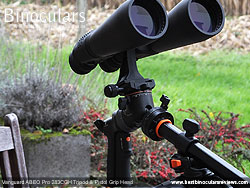
I think this system was designed for photographers to reach awkward/interesting angles and can help balance your setup when you are on very unlevel ground, but I have found it particularly useful for astronomy and aircraft spotting:
As you can see in the photos (right & above), it enables you to move the tripod away from the legs a little and thus be able to sit in a more comfortable position under the tripod and look up into the sky.
Tripod Heads: Versatility & Ease of Use
Ease of Aiming – Pistol Grip
As you can see from the photos on this page and indeed on many more on BBR site, when it comes to using binoculars on a tripod, I mostly use the pistol grip style of tripod head.
The main reason for this is aiming is very intuitive and fast which in my experience is not the case with your average and more commonly used pan-handles and especially not with normal ball heads. Don’t get me worn, these do have their ideal uses, but for most binoculars and most uses, I have found the pistol grip to be the best solution.
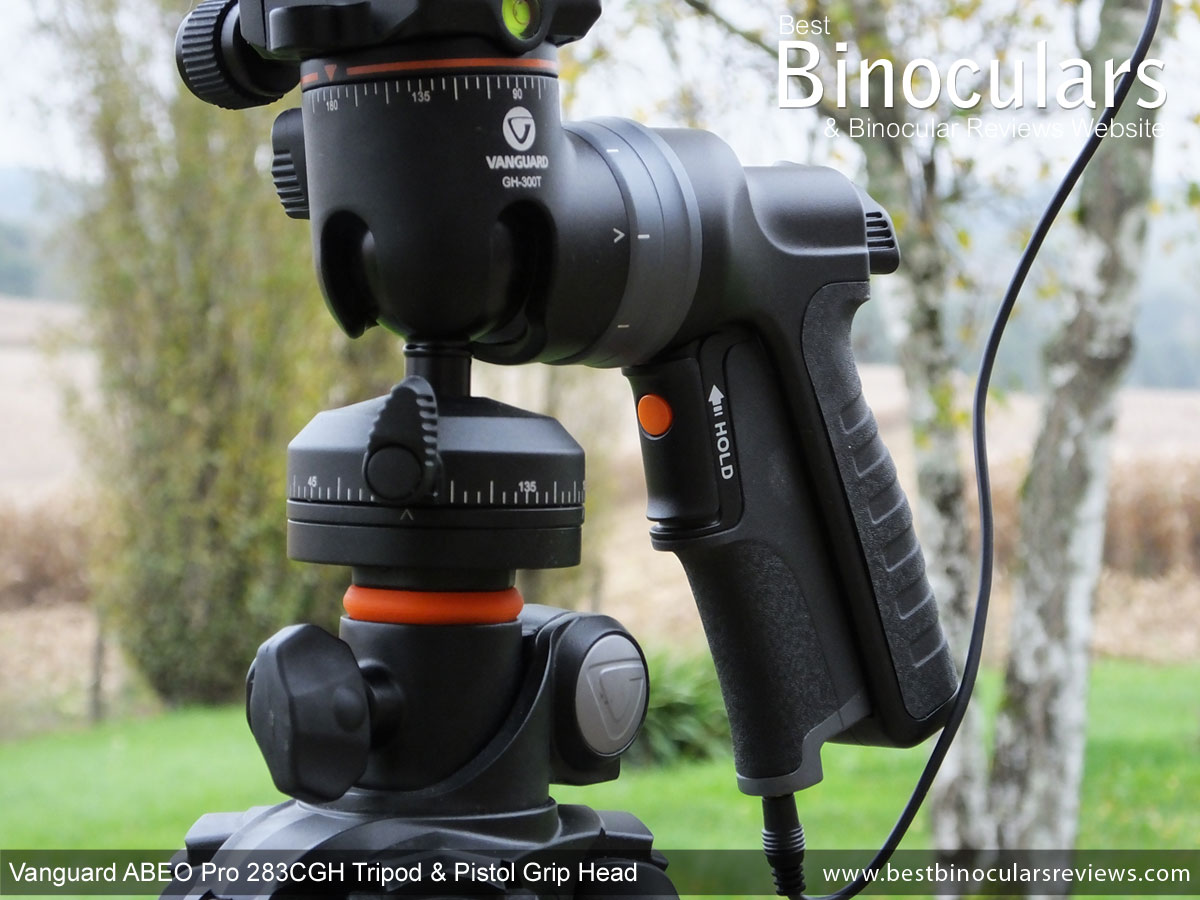
To aim with a pistol grip, you simply pull the trigger which releases the ball head and then turn the binocular in the direction you want to survey.
With pan-handles, there are two levers to adjust (one of tilt and one for panning) and with a normal ball head, the weight of the binocular on top can lead to it flopping over whilst you try and aim the system before the bird flies off!
Exceptions
There are occasions when I will swap out and use my MOVO GH1000 Gimbal Tripod Head

Whilst large and heavy, it is obviously not the ideal piece of kit to carry about in the field, but for the use with spotting scopes and large binoculars, it can work really well, especially for astronomy as the weightless setup makes heavier equipment very easy to aim.
A gimbal is especially nice to use when you have time to sit and relax and pan about, letting the tripod take all the weight and with a good gimbal head like my Movo, you can move in both the vertical and horizontal axes using just a single finger – perfect for astronomy when you are sitting outside holding a hot cup of coffee in the other hand!
Conclusion
So there you have it, I hope that this guide to what tripod I use with my binoculars answers some of your questions and that it has been of use.
More Info
You can also look and see what other gear I use here.
If you have any further questions, please feel free to contact me.
The post My Best Tripod for Binoculars: Astronomy & Terrestrial Surveillance appeared first on Best Binocular Reviews.

